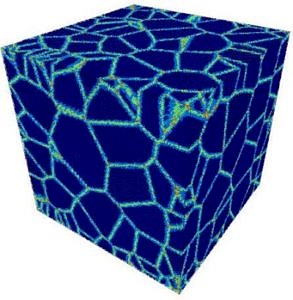Plastic deformation and failure of nanostructured metals
Themenbereich:
Modellierung & Simulation
Verantwortlicher Mitarbeiter:
Prof. Dr.-Ing. Erik Bitzek (Privatdozent)
Dr. Hao Lyu

Topological network of a 107 grain polycrystal of nanostructured aluminum.
Atoms are colored according to the topological entity that they belong to –
dark blue atoms signify grain interior, light blue and green atoms denote grain boundaries,
yellow atoms form triple junctions and red atoms form quadruple points (A. Prakash)
Nanocrystalline materials are characterized by typical grain sizes below 100 nm. These materials exhibit strengths up to ten times higher than that of conventional polycrystalline materials, whilst most of them simultaneously show a significant decrease in ductility.
A detailed understanding of the deformation and failure mechanisms is imperative to controlling and tailoring the mechanical properties of this new class of materials. Here, atomistic simulations provide a unique way to study the dislocation and grain boundary processes involved in plastic deformation.
In this project, we aim to study the influence of the grain boundary network topology on the deformation behavior and on collective processes. The statistical analysis of the individual slip events provides important quantitative information for continuum and mesoscale models of nanocrystal plasticity like quantized crystal plasticity (QCP).
Related publications:
- A. Prakash, D. Weygand, E. Bitzek [2017], Influence of grain boundary structure and topology on the plastic deformation of nanocrystalline aluminum as studied by atomistic simulations, International Journal of Plasticity 97 107 Link to paper
- A. Prakash, W. Nöhring, R.A. Lebensohn, H.W. Höppel and E. Bitzek [2015], A multiscale simulation framework of the accumulative roll bonding process accounting for texture evolution, Mater. Sci. & Eng. A 631 104 Link to paper
- E. Bitzek, C. Brandl, D. Weygand, PM. Derlet, and H. Van Swygenhoven [2009], Atomistic simulation of a dislocation shear loop interacting with grain boundaries in nanocrystalline aluminium, Model. Simul. Mater. Sci. Eng. 17 055008 Link to paper
- L. Li, P. M. Anderson, MG. Lee, E. Bitzek, PM Derlet, and H. Van Swygenhoven [2009], The Stress-Strain Response of Nanocrystalline Metals: A Quantized Crystal Plasticity Approach, Acta Mater. 57 812 Link to paper
- E. Bitzek, P. M Derlet, P. M Anderson and H. Van Swygenhoven [2008], The Stress-Strain Response of Nanocrystalline Metals: A Statistical Analysis of Atomistic Simulations, Acta Mater. 56 4846 Link to paper
- E. Bitzek, C. Brandl, P. M. Derlet, and H. Van Swygenhoven [2008], Dislocation cross-slip in nanocrystalline fcc metals, Phys. Rev. Lett. 100 235501 Link to paper
- C. Brandl, E. Bitzek, P. M. Derlet, and H. Van Swygenhoven [2007], Slip transfer through a general high angle grain boundary in nanocrystalline aluminium, Appl. Phys. Lett. 91 111914 Link to paper